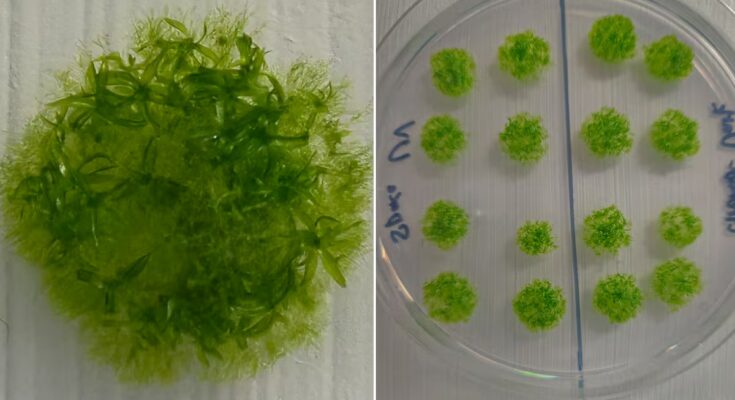A small primitive plant has sent a strong message from space: in these scenarios life on our planet could be much more resistant than we imagined. It’s about Physcomitrium patens. This moss managed to survive for nine months outside the International Space Station (ISS), a ship that orbits the Earth at an altitude of about 400 km. The discovery demonstrates for the first time that a primitive land plant can withstand prolonged exposure to cosmic elements.
This is research conducted by Japanese biologist Tomomichi Fujita, from Hokkaidō University (Japan), and published Thursday in the journal iScience. According to Fujita, when he began studying the resilience of these mosses, he didn’t imagine that one of his questions would take him beyond Earth’s atmosphere: Could these tiny plants survive in space?
The result surprised them: more than 80% of the spores withstood vacuum, ultraviolet radiation, extreme temperature variations and microgravity, and subsequently germinated in the laboratory upon returning to Earth.
Previous tests
Fujita explains that the idea came from a series of preliminary tests. In the lab, his team compared the tolerance of three types of tissue Physcomitrium patens, which were subjected to a simulated spatial environment: the protonemes (juvenile structures), thebrood cells” (resistant cells generated under stress) and sporophytes, which contain spores. “Previous literature already suggested that the sporophyte was the most resistant tissue”, explains the expert.
He says that, in those tests, exposure to freezing, heat, UV light and vacuum were analyzed individually. They all showed tolerance, but this did not fully confirm the resistance of the bryophyte to the simultaneous action of extreme factors, as happens in space. “Even if each individual stress was overcome, the simultaneous combination could reduce survival to almost zero,” says the researcher. A single weakness could trigger sudden, life-threatening damage, something impossible to predict based on these studies alone.
To test their findings, Fujita and his team sent hundreds of sporophytes (the stage of a plant that produces spores and from which the next generation will arise) to the ISS in March 2022. They traveled aboard the Cygnus NG-17 spacecraft. Once they reached their destination, the astronauts attached the samples to the outside of the station.
A revealing result
The moss was exposed to space for 283 days (just over nine months) and returned to Earth aboard the SpaceX CRS-16 mission in January 2023. Upon return it was taken to the laboratory for analysis.
Over 80% of the spores survived the intergalactic journey and managed to germinate in the laboratory. What I expected to be limited confirmation has become a demonstration of the biological resilience of which one of Earth’s oldest and smallest organisms is capable. “They can survive even in harsh conditions,” Fujita points out.
One of the study’s additional findings was the degradation of chlorophyll a under certain types of visible light. While this did not affect the resistance of the spores, which are protected within the sporangium, Fujita considers this a new discovery that still requires further research to understand its implications in ecosystems outside of Earth.
A primitive presence
For the biologist, the results are linked to the evolution of the first land plants. About 500 million years ago, when no vegetation existed on the planet, mosses were the pioneers in colonizing the earth.
They are able to settle in places without soil, such as newly formed volcanic islands. And, when it dies, its remains, degraded by bacteria, generate the first soil that allows other plants and animals to arrive later. Fujita explains: “Moss can form soil on its own and thus allow other animals and plants to grow.”
He adds: “The dead matter of mosses can be used to increase the green area.” This ability to create terrain where there is none is, for the researcher, a key clue to the role they might play in other worlds.
Biological systems in space
According to this expert, there is a possibility that mosses are capable of modifying the atmosphere, temperature, topography and ecology of another planet to make it habitable for terrestrial life or support biological systems. Even if he believes this possibility is real, it is still incipient.
He points out that studying how mosses survive in extreme conditions isn’t just about imagining extraterrestrial ecosystems. It can also teach us how to deal with changes on Earth.
Bryologist Jesús Muñoz, of the Superior Council of Scientific Research (CSIC), welcomes the news of the space experiment with a mixture of scientific interest and skepticism regarding the conclusions that accompany the work. For him, the resistance of moss spores has been a phenomenon known for decades, and he recalls that already in the 1970s the Spanish researcher Gonzalo Nieto Feliner carried out similar experiments by placing spores in boxes attached to the wings of airplanes to study their behavior during commercial flights. “It was the Earth’s atmosphere, but even then it was known that spores could withstand extreme conditions,” he points out.
Muñoz explains that there are research groups that have been studying for years how plants, especially those in the high mountains, develop compounds capable of protecting them from ultraviolet radiation. Also remember that the high resistance of spores has been documented for a long time: their natural drying and extremely hard chemical coatings insulate them from the outside in a way that few plant structures can match.
But his main criticism focuses on the idea of colonizing Mars or the Moon. “It seems like a way to avoid talking about the real problem,” he says. “We are destroying this planet. There is no point in thinking about solutions that are not solutions. No one will live on Mars in the foreseeable future, nor on the Moon. It is almost an excuse to continue to exploit the Earth without limits, as if we could replace it.”
Create land on Earth
Fujita and his team are not immune to this reality. Temperatures are rising, droughts are longer and some regions are becoming salinized. Understanding how mosses respond to severe stress, the Japanese biologist argues, could help us develop strategies for agriculture or the ecological restoration of our planet.
According to him, we might get some clues to improve our territory, “to create more land on Earth”. And he explains: “If we could grow mosses in space, they could also contribute to the formation of soil on Earth, the increase of green areas, photosynthesis and the production of oxygen.”
The next step, he says, is to study other, even more resistant species of moss, as well as mutant versions of it Physcomitrium patens, which allow us to decipher which genetic networks allow this extraordinary tolerance. Among the candidates he mentions Syntrichia ruralis, Bryum argenteum and other species recognized for survival in extreme environments.



